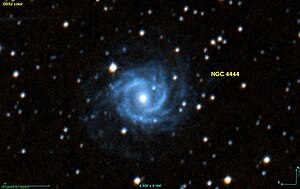NGC 4444
| Galaxy NGC 4444 |
|
|---|---|

|
|
| AladinLite | |
| Constellation | centaur |
|
Position equinox : J2000.0 , epoch : J2000.0 |
|
| Right ascension | 12 h 28 m 36.4 s |
| declination | -43 ° 15 ′ 42 ″ |
| Appearance | |
| Morphological type | SAB (rs) bc |
| Brightness (visual) | 12.2 mag |
| Brightness (B-band) | 13.0 likes |
| Angular expansion | 2.5 ′ × 2.3 ′ |
| Position angle | 119 ° |
| Surface brightness | 13.9 mag / arcmin² |
| Physical data | |
| Redshift | 0.009737 ± 0.000017 |
| Radial velocity | (2919 ± 5) km / s |
|
Stroke distance v rad / H 0 |
(122 ± 8) · 10 6 ly (37.4 ± 2.6) Mpc |
| history | |
| discovery | John Herschel |
| Discovery date | March 15, 1836 |
| Catalog names | |
| NGC 4444 • PGC 41043 • MCG -07-26-007 • IRAS 12259-4259 • 2MASX J12283639-4315423 • SGC 122555-4259.1 • GC 3000 • h 3393 • HIPASS J1228-43 | |
NGC 4444 is a barred spiral galaxy of the Hubble type SAB (rs) bc in the constellation Centaur in the southern sky , which is an estimated 122 million light years away from the Milky Way .
Due to their southern location in the sky, it is not possible to observe them from Central Europe .
The object was discovered on March 15, 1836 by John Herschel .
